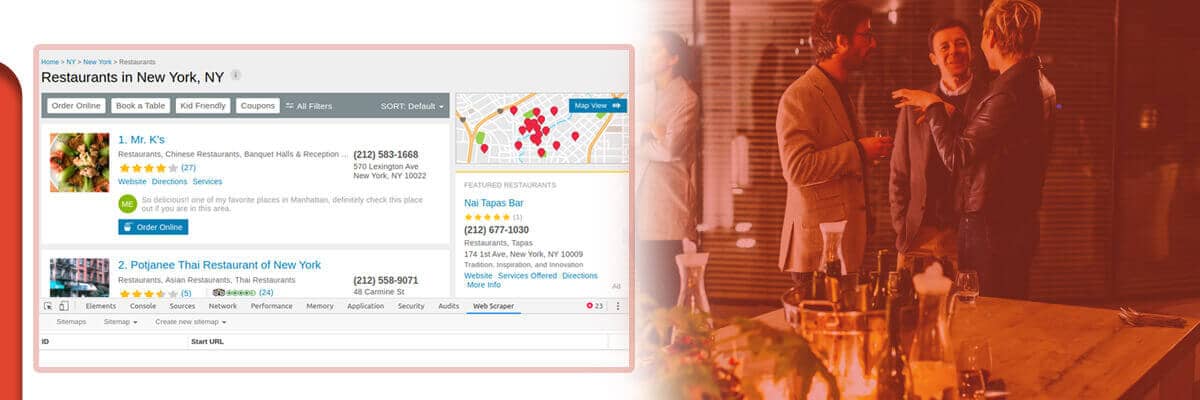Let's talk!
We'de love to hear what you are working on. Drop us a note here and we'll get back to you within 24 hours.

We'de love to hear what you are working on. Drop us a note here and we'll get back to you within 24 hours.

Launched in 2005, Google Maps has progressed a lot and gets different usages besides how to reach from point X to point Y. Its most general offerings include satellite imagery, real-time traffic maps, aerial photographs, as well as route planning through bikes, cars, public transport, etc. However, it is heavily utilized to get local restaurants as well as find out more about them. Scraping Google Maps data helps restaurants scrape food data.
Let’s assume that you have shifted to a new city and want to find a good restaurant nearby. The most general thing to do is type the keyword “restaurants” in Google Maps and get the ones that are within your budget and have maximum reviews. Google Maps also allows people to get the timing when a restaurant might be open, as well as even allows one to edit data for any changes. All the data points, together with valued customer reviews, could prove to be extremely helpful if one can gather data properly as well as store that in usable formats.
Google Maps is created from data that is over 20 Petabytes, and a huge part of that is made from millions of smaller businesses across cities and towns. As nearly 13% of all Google searches are associated with its maps, this huge dataset is surprising. This huge user base and dataset together assisted in capturing nearly 67% of the navigation apps market (till 2018). Data scraping Google Maps assists in extracting data resources from Google.

If you are looking for food or a restaurant service, then you should scrape the following data fields:
Local restaurant data proves to be extremely important if utilized correctly. It could answer the questions, which can be solved through data only:

Today, different public perceptions of restaurants are as vital as the products that they sell. You could keep track of the brand images of all restaurants by tracking the newest reviews on various platforms. Scraping restaurant data from Google Maps has thousands of reviews of millions of restaurants. The data offers great datasets to perform sentiment analysis and assists restaurants in analyzing what they get right as well as where they missed the mark. Scraping Google Maps data helps to extract the necessary data fields.
Getting insights into your competitors is as vital as getting your house in good shape. That’s the reason why businesses want to scrape data from different restaurants that are parallel to theirs. This data could be easily available using Google Maps. Then, the data can be utilized to get insights into price strategies, opening as well as closing timings, customer perception, add-on services, and more. This data can be utilized to find the space for improvement and make data-supported restaurant decisions.

You can scrape data related to domestic restaurants and food from Google Maps in many ways. Let’s discuss a few ways:

Writing codes to extract a site like Google Maps could prove to be extremely challenging. That’s because a user interface becomes frequently updated, and different kinds of restaurants have their listings in various formats, usually sporting various data points as well as features. There are also risks of being blacklisted if you result in hitting different map pages from similar IPs in a shorter period. Making a data scraping solution, which might read the data associated with local restaurants at various locations as well as an update in real-time, might not be difficult as it is expensive to make but also comes up with additional overhead of maintenance and infrastructure setup.
The majority of these software solutions are utilized by the companies where a restaurant team (that has no coding knowledge), handles data scraping requirements. Whereas they could be utilized with training, you are guaranteed to run in the roadblocks for lacking different features. In addition, re-learning for new employees and constantly handling configuration and infrastructure changes would be key priorities for a restaurant team.
DaaS solution providers are data-based end-to-end service providers that generally handle the majority of stages in data workflow, providing you with two things:
Generally, the prices are based on the total amount of data that needs to be extracted. Therefore, you should only pay for data points and the number of restaurants for which you need data. In a long time, you will only pay for the updated data points to drive the cost down.
Our enterprise-grade, well-managed, and end-to-end solutions can assist you in having all the data points needed from restaurants in all locations around the world. Any type of customized requirements, like filters for some kinds of restaurants, could also be implemented if needed.
At Foodspark, we offer a lower latency food and restaurant data scraping solution that revives data in real time. Our well-managed food data scraping services take care of the maintenance and infrastructure setup. Our complete cloud-based solutions consider various integration requirements that customers might have. Therefore, we offer data in different formats like JSON, CSV, or XML through the means of REST APIs, S3, or DropBox. Your journey of scraping data from Google Maps, as well as integrating it into the restaurant workflow could be a continuous upgrade using our DaaS solutions.
For all your food and restaurant data scraping service requirements, contact Foodspark or ask for a free quote!
January 21, 2025 B2B marketplaces use data collection to expand and maintain relevance in the food industry. Organizations can improve...
Read moreJanuary 2, 2025 Web scraping has now become an important strategy in the accelerating world of e-commerce, especially for businesses...
Read more